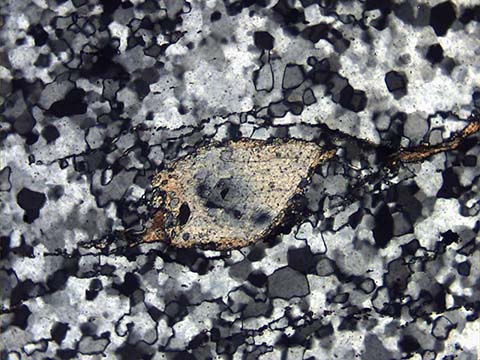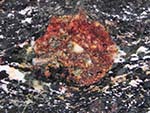The Bani Hamid granulites
Provisional abstract (Waters, Searle, Cherry, ms.):
The ~96 Ma Semail (Oman)
ophiolite includes an intact thrust slice of Tethyan oceanic crust and upper mantle
formed above a NE-dipping subduction zone that was the site of initiation of obduction.
The 'normal' metamorphic sole of the Semail ophiolite comprises a highly condensed
sequence of hornblende + plagioclase ± garnet amphibolites with small enclaves of
garnet + clinopyroxene granulites immediately beneath the Mantle sequence peridotites,
tectonically underlain by a series of epidote amphibolite and greenschist facies
lithologies in a highly deformed ductile shear zone. Peak metamorphic conditions
of 770-900°C and 11-15 kbar indicate metamorphism at depths far greater than
can be accounted for the preserved thickness of the ophiolite (~15 km). In the northern
Oman mountains the Bani Hamid thrust sheet, 1.2 km thick, is composed of isoclinally
folded granulite facies rocks within the middle of the Mantle sequence peridotites,
exhumed by late-stage out-of-sequence thrusting bringing a slice of lower crust rocks
to the surface. The Bani Hamid thrust slice comprises two-pyroxene quartzites (± hbl,
crd, sapphirine), diopside + andradite garnet + wollastonite + scapolite calc-silicates
and amphibolites (hbl + pl ± cpx ± bt) with localised partial melting,
intruded by hornblende pegmatites. The Bani Hamid granulites represent metamorphosed
cherts and calcareous turbidites probably derived from the distal Haybi complex and
Oman Exotic limestones with their alkali basaltic substrate. Metamorphic modelling
using the programme THERMOCALC in the system NCKFMASHTO gives peak pressures of ~6.9kbar,
much lower than those of the metamorphic sole, suggesting a different origin.
A minimum of 130 km shortening is recorded by restoration of the major folds, and
more than 30 km offset has occurred along the west-directed breaching out-of-sequence
Bani Hamid thrust. These rocks may be representative of deep-level duplexes imaged on
recent seismic sections across the northern Oman-UAE Mountains.
Crucial evidence for the exhumation and emplacement history of the Bani Hamid unit comes from the sequence of development of deformational microstructures in the quartzite units, coupled with the retrograde mineral associations developed by the breakdown of granulites-facies phases.
For a microstructural slide show and the inferred P-T-time-deformation interpretation, see the Bani Hamid quartzites photo album on the teaching section of the OESIS site (opens in a new window/tab).

A sigma-porphyroclast of amphibole (indicating dextral shear) in finely-recrystallized quartz, which shows neoblasts of similar size to the fine subgrain structure of strained grains. Specimen JC85, crossed polars, field width 0.8 mm.

